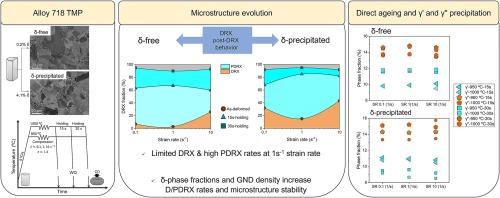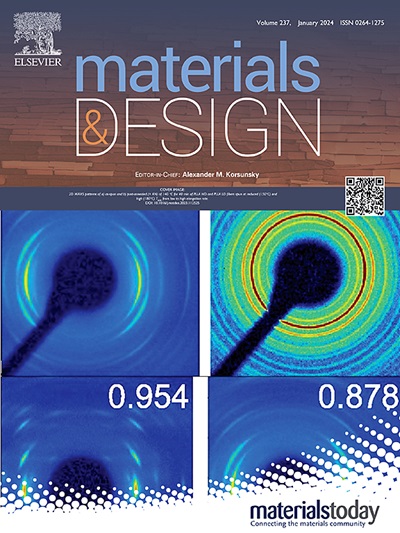对合金 718 发动机盘动态软化和后动态软化动力学的新认识
IF 7.6
2区 材料科学
Q1 MATERIALS SCIENCE, MULTIDISCIPLINARY
引用次数: 0
摘要
众所周知,合金 718 的动态和动态后再结晶(DRX 和 PDRX)动力学取决于应变速率、变形温度以及异质起始材料中 δ 相的比例。直接老化(DA)需要更好地控制这些机制,以释放下一代航空发动机盘片的高温强度。目前对(后)动态机制及其对γʹ和γʹ共沉淀的影响的认识还存在差距。我们的目的是揭示控制热机械加工(TMP)后晶粒大小和再结晶分数的关键参数,以模拟后动态微结构演变。采用短暂的等温奥氏变形退火来评估恢复行为。由于动态恢复时间有限,在 950 °C 时,应变速率为 1 s-1 时,DRX 被抑制,而由于存储能量较高,PDRX 占主导地位。1000 °C时,在所有条件下都能获得完全再结晶的微观结构。δ相的存在提高了 DRX 和 PDRX 的速率,并促进了微观结构的稳定性。我们的研究结果以预测 DA 过程中 PDRX 和沉淀动力学的模型为基础。本文章由计算机程序翻译,如有差异,请以英文原文为准。

New insights into the kinetics of dynamic and post-dynamic softening in Alloy 718 engine disks
The dynamic and post-dynamic recrystallisation (DRX and PDRX) kinetics of Alloy 718 are known to be dependent on the strain rate, deformation temperature, and the fraction of the δ-phase in the heterogeneous starting materials. Better control of these regimes is required for direct ageing (DA), to unlock superior high-temperature strength in next-generation aeroengine disks. There are gaps in the current understanding of the (post-)dynamic regime and its effect on γʹ and γʹʹ co-precipitation. Our aim is to reveal the critical parameters controlling the grain size and recrystallised fractions after thermo-mechanical processing (TMP) to model the post-dynamic microstructure evolution.
Two initial microstructures with different δ-phase fractions are subjected to 1.4 strain with 0.1–10 s−1 strain rates to simulate industrial conditions. A short isothermal ost-deformation annealing is applied to assess the restoration behaviour. DRX is suppressed at strain rates >1 s−1 at 950 °C due to limited time for dynamic restoration, while PDRX become predominant due to higher stored energy. At 1000 °C, a fully recrystallised microstructure is achieved in all conditions. The presence of δ-phase increases DRX and PDRX rates and promotes microstructure stability. Our results are underpinned by models that predict PDRX and precipitation kinetics during DA.
求助全文
通过发布文献求助,成功后即可免费获取论文全文。
去求助
来源期刊

Materials & Design
Engineering-Mechanical Engineering
CiteScore
14.30
自引率
7.10%
发文量
1028
审稿时长
85 days
期刊介绍:
Materials and Design is a multi-disciplinary journal that publishes original research reports, review articles, and express communications. The journal focuses on studying the structure and properties of inorganic and organic materials, advancements in synthesis, processing, characterization, and testing, the design of materials and engineering systems, and their applications in technology. It aims to bring together various aspects of materials science, engineering, physics, and chemistry.
The journal explores themes ranging from materials to design and aims to reveal the connections between natural and artificial materials, as well as experiment and modeling. Manuscripts submitted to Materials and Design should contain elements of discovery and surprise, as they often contribute new insights into the architecture and function of matter.
 求助内容:
求助内容: 应助结果提醒方式:
应助结果提醒方式:


